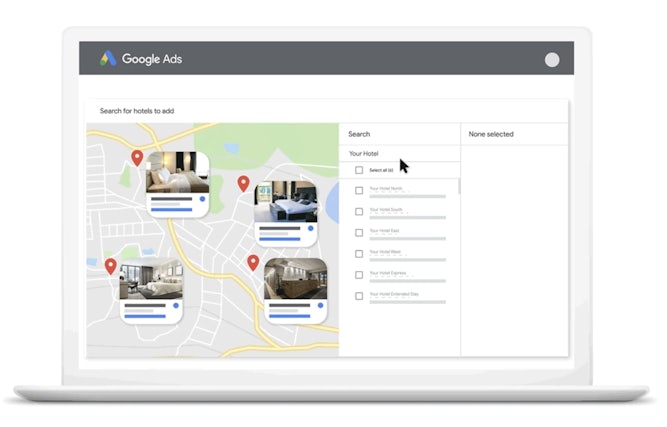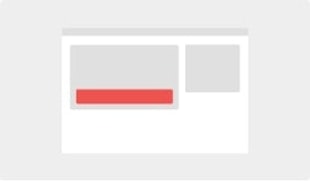Welcome to the latest blog from Impression on Paid Search Industry Updates, where we uncover the latest PPC trends to help you stay ahead of the curve.
Keep reading to discover:
The traffic light imagery is featured throughout to indicate the importance of each new update – red denoting a priority update, green representing a less important update and amber lying somewhere in the middle.
Google announces new Performance Max feature for travel goals

Kicking things off in March is an exciting new feature announcement for Google, which will be especially useful for advertisers within the hotel industry. Performance Max for travel goals is Google’s latest step towards AI-powered advertising.
Similar to traditional Performance Max campaigns, these will allow advertisers to have their ads shown across various channels of Google’s ecosystem within a single campaign. Making use of YouTube, Display, Search, Discover, Gmail and Maps, as well as the new Hotel Ads channel coming later this year. During set-up, individual hotel properties can be selected using maps, which will then auto-populate copy, images and URLs for every ad format, allowing for edits to be made afterwards.

This feature has been further leveraged through the insights page, which will now offer property-level reporting. This will offer traditional insights features such as search term insights and search trends, but at a more granular, property-level view with more travel-specific recommendations.
The Thailand-based hotel chain, Minor Hotels has been utilised as a case study for early testing of this feature, with Google stating that the feature allowed the firm to speed up campaign creation across their portfolio of over 500 properties, leading to a 76% increase in ROAS and an 86% increase in bookings.
What does this mean for me?
Performance Max campaigns have become a staple feature of many Google Ads accounts in the last year, and have shown great success across a number of our clients. Advertisers working within the hotel industry will find great use in this feature specifically crafted for them.
Allowing support for up to 100 properties per campaign, and providing automatic unique messaging and creative assets, we’re sure that this will be especially helpful for larger firms in cutting down set-up times and reducing costs.
However, as always, these are just assumptions, and we will need time to see how this new campaign type will perform in different scenarios. With Google’s push towards AI-assisted advertising continuing, along with being armed with all the learnings gathered from the traditional Performance Max campaign launch, we’re hoping that these new campaigns launch in a fairly optimised state.
YouTube to retire overlay ads in April

Another change Google has announced is bound to hit imminently, as YouTube’s overlay ad format is being retired on April 6th, 2023.
This change comes as Google themselves have admitted that overlay ads, in general, do not perform as well as the other ad formats offered on the platform. Describing them as disruptive for viewers, the removal of this format is aimed at improving the overall viewer experience, and benefit advertisers by shifting viewer engagement to ad formats that are more likely to appeal rather than distract.

What does this mean for me?
This news is especially important for advertisers who currently rely on this ad format as part of their video strategy, as they will be forced to migrate to other ad formats in the coming weeks. As noted by Nicole Farley, over at Search Engine Land, the affordability of these ads was one of their major advantages compared to other formats, and being completely removed may affect smaller advertisers considerably.
Alongside the fact that this is likely to increase competition across other ad formats, as there will be less choice of where to allocate budgets, so bid auctions for other formats are likely to increase in price.
This change is likely to impact advertisers across the board, and is definitely worth considering how it may affect your strategy over the coming months!
GA4 custom channel groups

Google has announced a new feature that will allow advertisers to build personalised channel groups, allowing users of the platform to tailor their channels to suit their website’s traffic sources.
A custom channel group is essentially a set of channels that contain rule-based categories of a website’s different traffic sources. Advertisers will be able to use custom channel groups in any of their reports that support default channel groups as a primary dimension already (e.g., the Acquisition reports). Custom channel groups can be used as primary or secondary dimensions and are also available as dimensions in custom reporting, explorations, and building conditions for audiences.
This new feature will give advertisers the flexibility to alter channel names according to their preferences, tweak the criteria for each channel, and add or delete channels if they seek a broader or more targeted outlook. Accessible to all users, custom channel groups can be employed to obtain current and historical insights into campaign channels.
There are currently the following limitations in the GA4 Custom Channel Groups:

What does this mean for me?
Advertisers will find that one of the many benefits of custom channel groups is enhanced data analysis through being able to segment and analyse their websites traffic sources far more efficiently, essentially allowing them to identify trends, patterns and opportunities when overlooking their user’s behaviour. Ultimately, this will lead to more effective and informed decision-making when it comes to targeting, budget allocation, and campaign adjustments.
To find out how to get started with using custom channel groups in GA4, Google has created a useful guide here.
Microsoft launches local search ads for Bing and more

Increasing regional visibility in Bing’s local search results is Microsoft’s newest feature to the platform. This new ad experience will help businesses stand out from competitors and give them a far greater presence on Bing’s search results page and Bing Maps on PC.
Advertisers using Bing’s local search ads will be able to promote their products and services to potential customers around the local area. These ads also have the ability to showcase key information such as the company’s location, contact number and hours of operation.
This new update brings an opportunity to businesses that widely rely on in-store purchases and on foot traffic, thereby making it easier for their business to reach potential customers.
Microsoft has also provided Call Extensions for these localised ads. On mobile devices, users will be able to click on the business’ contact information, allowing them to reach the business instantly. Users who are on a tablet or PC will also be able to benefit from this function by offering a free in-browser Skype call.

What does this mean for me?
This new feature will allow advertisers to reach their local audiences, making it easier for local businesses to reach customers in the right location. It will be especially useful to advertisers who are seeking new ways of increasing their visibility within the local search results page.
These local ads give customers easy access to the business’s address, phone number and visually clear directions next to the advertisement, which in return, will make it easier for them to travel in-store, thereby increasing their chance of making a purchase. Bing’s local search ads will also help businesses target more interested prospects. This is due to the fact that the closer they are to the business, the more likely they are to visit.
Look out for our next blog in April for more paid search industry updates to inspire your PPC strategy. If you want to talk about your business aspirations, get in touch!



